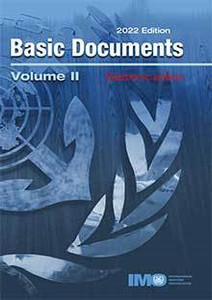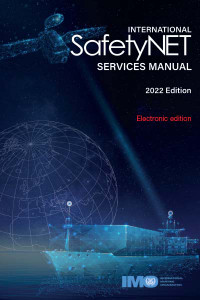
The Organization and Management volume discusses the global search and rescue (SAR) system concept, establishment and improvement of national and regional SAR systems, and cooperation with neighbouring States to provide effective and economical SAR services.
A new edition of the IAMSAR Manual is published every three years. The 2022 edition includes amendments, adopted by the International Civil Aviation Organization (ICAO) and approved by the Maritime Safety Committee of the International Maritime Organization (IMO) at its 103rd session in May 2021 by means of MSC.1/Circ.1640, which become applicable on 1 June 2022.
The primary purpose of the three volumes of the International Aeronautical and Maritime Search and Rescue Manual (IAMSAR Manual) is to assist States in meeting their own search and rescue (SAR) needs, and the obligations they accepted under the Convention on International Civil Aviation, the International Convention on Maritime Search and Rescue, 1979 and the International Convention for the Safety of Life at Sea, 1974 (SOLAS). These volumes provide guidelines for a common aviation and maritime approach to organizing and providing SAR services. States are encouraged to develop and improve their SAR services, cooperate with neighbouring States and to consider their SAR services to be part of a global SAR system.
Each volume of the IAMSAR Manual is written with specific SAR system duties in mind, and can be used as a stand-alone document, or, in conjunction with the other two volumes, as a means to attain a full view of the SAR system. Depending on the duties assigned, it may be necessary to hold only one or two, or all three volumes.
The Organization and Management volume (volume I) discusses the global SAR system concept, establishment and improvement of national and regional SAR systems, and cooperation with neighbouring States to provide effective and economical SAR services;
The Mission Coordination volume (volume II) assists personnel who plan and coordinate SAR operations and exercises; and The Mobile Facilities volume (volume III) is intended to be carried aboard rescue units, aircraft and vessels to help with performance of a search, rescue, or on-scene coordinator function and with aspects of SAR that pertain to their own emergencies.
Contents
Foreword
Abbreviations and acronyms
Glossary
Chapter 1 General system concept
1.1 Establishing services
1.2 Benefits of services
1.3 Legal basis for services
1.4 Basic system functions
1.5 System management and support
1.6 The global concept
1.7 National and regional systems
1.8 Search and rescue (SAR) operations by maritime rescue services in time of armed conflict
Chapter 2 System components
2.1 SAR as a system
2.2 Communications
2.3 Rescue coordination centres
2.4 Rescue sub-centres
2.5 SAR facilities
2.6 On-scene coordinator (OSC) and aircraft coordinator (ACO)
2.7 Support facilities
Chapter 3 Training, qualification, certification and exercises
3.1 Building professionalism
3.2 Training specifics
3.3 Exercises
Chapter 4 Communications
4.1 Introduction
4.2 Basic functions and requirements
4.3 Important factors for SAR communications
4.4 Mobile equipment
4.5 Land-based infrastructure
4.6 Supplemental capabilities
4.7 MEDICO communications
4.8 Radio call signs for aircraft involved in a search and rescue operation
4.9 Social media
Chapter 5 System management
5.1 Understanding the SAR system
5.2 Planning processes
5.3 Organization
5.4 Resources
5.5 Leadership and operations.
5.6 System assessment
5.7 Dealing with the media
Chapter 6 Improving services
6.1 Managing for success
6.2 Reducing system problems
6.3 Applying risk management
6.4 Cooperating to improve services
6.5 Reducing response time
6.6 Mass rescue operations
6.7 Multiple aircraft SAR operations
6.8 Research and development
6.9 Other factors
Appendix A Sample legislation establishing a SAR organization
Appendix B Supply pictograms
Appendix C Sources for SAR assistance
Appendix D Information sources
Appendix E False alerts
Appendix F Alerting and locating capability preferences for new mobile satellite systems used for distress alerting
Appendix G Mobile communication services
Appendix H National self-assessment on search and rescue system
Appendix I SAR agreements
Appendix J Sample national SAR committee interagency agreement
Appendix K Model agreement for the division of responsibility between the SAR Authority and the Air Traffic Services provider in providing emergency response services for aircraft
Appendix L Applying risk management principles to assess SAR response and SAR system performance
Appendix M National responsibilities of Contracting States under international conventions
Appendix N Sample contract between RCC and TMAS for the provision of medical advice and assistance to masters of ships at sea
Appendix O Sample template for a joint search and rescue exercise
As a specialized agency of the United Nations, IMO is the global standard-setting authority for the safety, security and environmental performance of international shipping. Its main role is to create a regulatory framework for the shipping industry that is fair and effective, universally adopted and universally implemented.
In
other
words,
its
role
is
to
create
a
level
playing-field
so
that
ship
operators
cannot
address
their
financial
issues
by
simply
cutting
corners
and
compromising
on
safety,
security
and
environmental
performance.
This
approach
also
encourages
innovation
and
efficiency.
Shipping
is
a
truly
international
industry,
and
it
can
only
operate
effectively
if
the
regulations
and
standards
are
themselves
agreed,
adopted
and
implemented
on
an
international
basis.
And
IMO
is
the
forum
at
which
this
process
takes
place.
- Number of Pages:
- 40
- Published Date:
- April 2022
- Book Height:
- 250 mm
- Book Width:
- 210 mm
- Author:
IMO
- Preview:
- Yes
- Publication Date:
- April 2022






